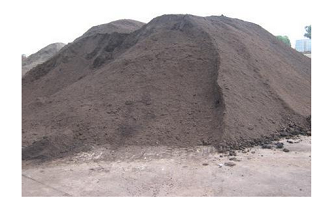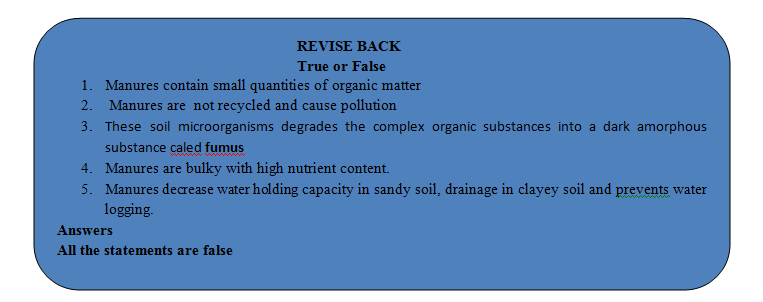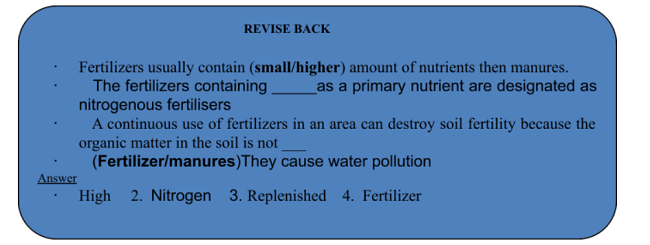
MANURES & FERTILISERS
Improvement of food resources of Class 9
MANURES & FERTILIZERS
MANURE:
A manure is a mixture of various decomposed organic substances like dead leaves, city garbage, agricultural wastes, animal dung, crop residue etc. through the action of microbes. Manure increases the fertility and productivity of crops . As they contain plenty of organic compounds and almost all the essential elements required by the plants .
Characters :
- Manures are organic substances obtained through the decomposition of plant wastes (like straw) and animal wastes (like cow dung). The decomposition is brought about by the action of microbes.
- Manures contain large quantities of organic matter.
- Manures contain nutrients in small quantities and therefore are needed to be supplied to crops in large quantities.
- Manures are not nutrient specific. For this reason, manures are not of much help when a specific nutrient is required for a particular crop.
- Manures are bulky. So it is not convenient to store and transport manures.
- Manures are recycled and do not cause pollution.
- They enrich the soil with nutrients.
- Being rich in organic matter, manures improve soil texture and soil aeration. Water holding capacity in case of sandy soils and drainage in clay soil is increased.
Types of Manure:
The manures are of three types :
- Farmyard manure
- Compost
- Green manure
Farmyard Manure
It is the oldest manure known to mankind. It is made-up of dung of farm animals, urine, farm refuse, and crop residues (plant remains) which are allowed to partial decay with the help of soil microorganisms. These soil microorganisms degrades the complex organic substances into a dark amorphous substance caled humus. The humus is easily assimilated by plants. These manure loosens the soil, increases its aeration and makes the soil more fertile. It provides various organic substances to plant for normal growth and development. The residue of gobar gas plant is a type of farmyard manure.
Compost
It is prepared by degrading the dung of farm animals, crop residues, farm wastes and other organic debris in specially designed pits or the degrading material is covered by a mud pack to prevent water logging during the rainy season. It takes about 6-8 months to prepare the compost.
Green manure
To prepare it, many leguminous and non-leguminous crops are grown in the field and ploughed back into the soil while they are still green and young. This practice is done for nitrogen, phosphorous, calcium, sulphur and other minerals enrichment of the soil. The complex organic matter present in the plants is decomposed by the action of micro-organisms. Apart from supplying nutritional requirements, it reduces alkalinity, prevents soil erosion also. Green manures enhance crop yield by 30 to 50 percent plants like Crotolaria juncea (sunn hemp), Sesbania aculeata (dhaincha), Vigna sinensis (lobia) and various other plants are used as green manures in India.

Manure
Advantages of using manure:
- Many organic substances of biological origin present in the manure can be easily degraded and absorbed by plants. Thus, excessive use of chemical fertilizers can be reduced.
- Manures help in recycling of biological waste (farm waste).
- The manure loosens the soil, increases its aeration and makes the soil fertile.
- t increases water holding capacity in sandy soil, drainage in clayey soil and prevents water logging.
Disadvantages of using manures
- Manures are bulky with low nutrient content.
- The nutrients of manures are released slowly, not keeping pace with the high and rapid demand of nutrients by improved high-yielding hybrid varieties of crops.
- Being bulky and voluminous, they are inconvenient to handle, store and transport.
- Moreover, manure is not nutrients specific and, hence, it is not much useful when a particular nutrient is required in the soil for a particular crop.

FERTILIZERS:
These are commercially manufactured inorganic salts or an organic compound containing one or more essential plant nutrients like Nitrogen, Phosphorus or Potassium which are used for increasing soil fertility. Fertilizers usually contain higher amount of nutrients then manures hence required in small quantities.
Characters:
- Fertilizers are inorganic or organic compounds containing the necessary plant nutrients.
- They contain much higher amount of nutrients in comparison to manures, and are therefore, required in very small quantities.
- They are manufactured commercially from chemicals, and are marketed in concentrated form.
- They are easy to use, store and transport.
- Being soluble in water, they are easily absorbed by the plants.
Fertilizers are generally nutrient – specific i. e. these supply only one or more specific nutrients
Types of fertilizers:
They are classified on the basis of concentration of primary plant nutrients. They can be divided into three main categories :
- Nitrogenous fertilisers
- Phosphatic fertilisers
- Potassic fertilisers
Nitrogenous Fertilisers
The fertilisers containing nitrogen as a primary nutrient are designated as nitrogenous fertilisers. Calcium and sulphur, if present, are to be treated as secondary nutrients.
Some common nitrogenous fertilisers are
Urea - NH 2 CONH 2 Sodium nitrate - NaNO 3
Calcium nitrate - Ca(NO 3 ) 2 Ammonium Sulphate - (NH 4 ) 2 SO 4
Ammonium Chloride - NH 4 Cl Ammonium nitrate - NH 4 NO 3
Phosphatic Fertilisers
They contain phosphorus as a primary nutrient. The phosphorus content in fertilisers is expressed in oxidised from (P 2 O 5 ).
Some common phosphatic fertilisers are :
Ammonium phosphate - (NH 4 ) 3 PO 4
Aluminium phosphate - AlPO 4
Superphosphate or Calcium dihydrogen phosphate - Ca(H 2 PO 4 ) 2
Ammonium hydrogen phosphate - (NH 4 )H 2 PO 4
Potassic Fertilisers
Here, the primary nutrient is potassium. Potassic fertilisers are in two forms i.e., chloride form and non-chloride form.
Some common potassic fertilisers are :
Potassium chloride - KCl
Potassium sulphate - K 2 SO 4
Potassium nitrate - KNO 3
Advantages of using fertilizers
- They enhance good vegetative growth (leaves, branches and flowers) to make the plants healthy.
- They are nutrient specific.
- Fertilizers are generally used by rich farmers to ensure higher yield.
Disadvantages of using fertilizers:
- The fertilizers should be applied carefully in terms of proper dose, time and observing pre and post-application precautions for their complete utilization. For example, sometimes fertilizers get washed away due to excessive irrigation and are not fully absorbed by the plants. This excess fertilizer then leads to water pollution.
- A continuous use of fertilizers in an area can destroy soil fertility because the organic matter in the soil is not replenished.
- The microbes present in the soil get harmed by continuous use of chemical fertilizers.
- Fertilizers give short-term benefits whereas manures give long-term benefits.
Table: Differences between manures and fertilizers |
||
|
S.No. |
Manures |
Fertilizers |
|
1. |
Manures are organic natural substances derived from the decomposition of biological materials (plants andanimal residues) |
Fertilizers are inorganic or organic substances. |
|
2. |
Manures contain organic matter in large quantities. |
Organic matter is not present. |
|
3. |
Manures contain nutrients in small quantities, and are needed in large quantities. |
Fertilizers contain much higher amount of nutrients, and are required in very smallquantities. |
|
4. |
They are not nutrient – specific. |
These are nutrient - specific. |
|
5. |
They are prepared in field and villages. |
These are manufactured in factories. |
|
6. |
Manures are bulky substances. So, these are inconvenient to store, use and transport. |
These are available in concentrated form. So these are easy to store, use and transport. |
|
7. |
Manures do not cause pollution. |
They cause water pollution. |










